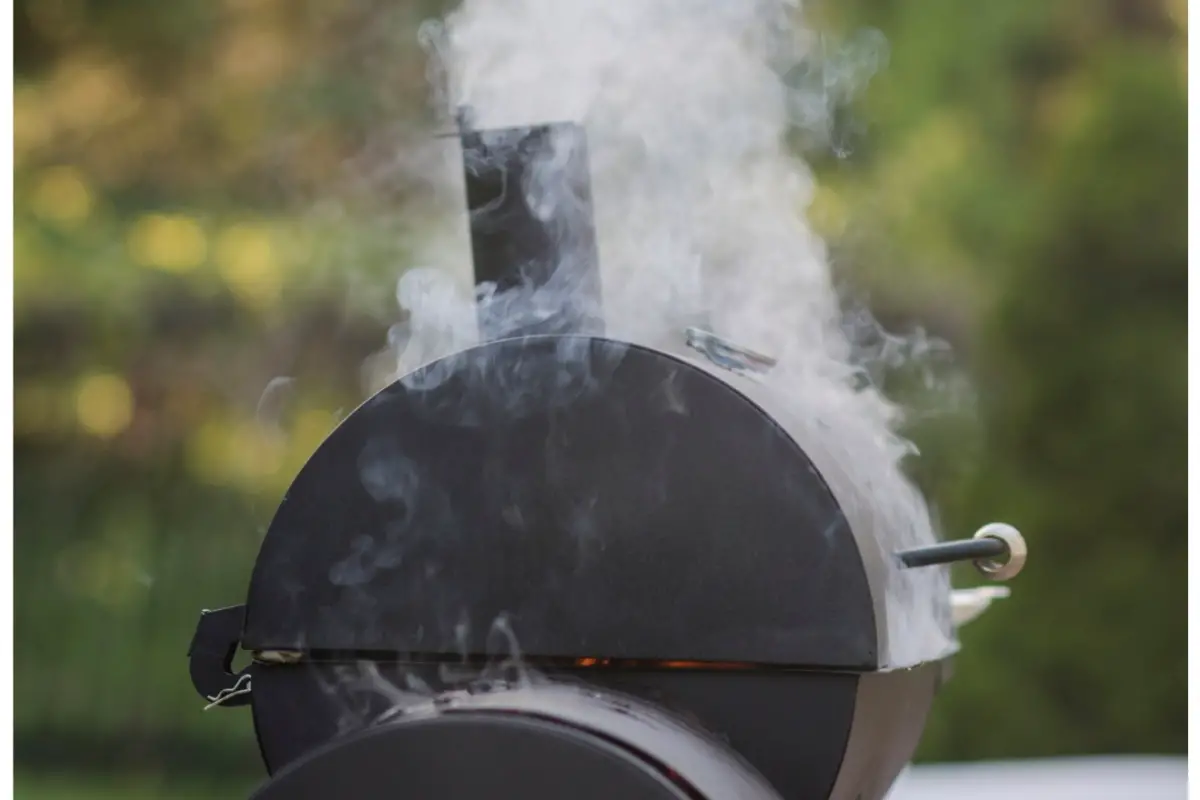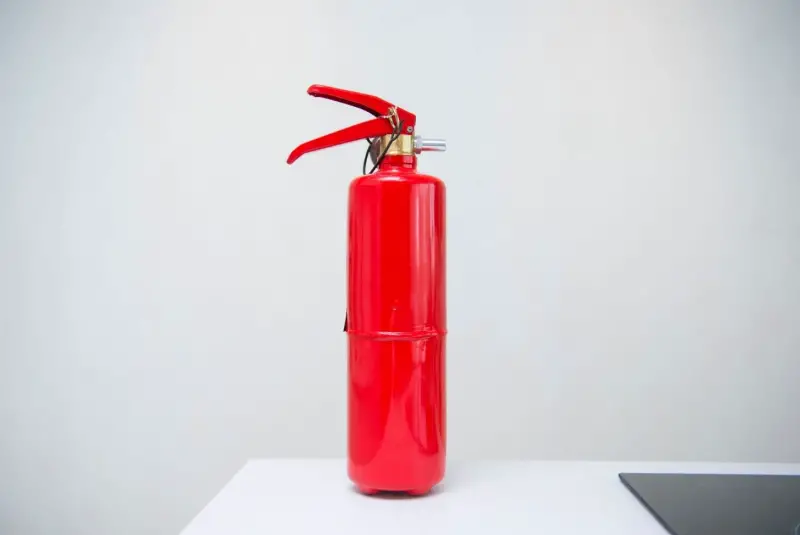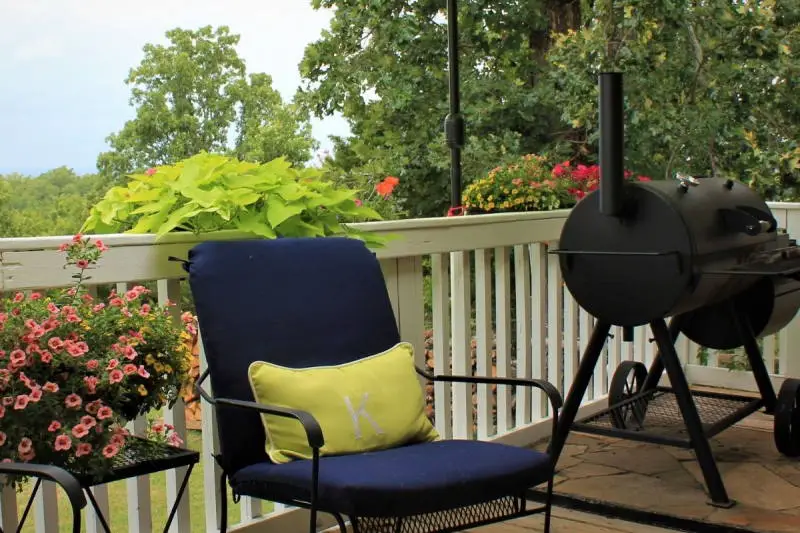
Meat smokers were previously only found in restaurants, groceries, and meat product manufacturers, but they’ve now permeated the home front. They produce wonderful-smelling, tasty meats but are also known to cause fires, according to statistics. Are meat smokers a fire hazard, and how can you limit their potential dangers?
Meat smokers are potential fire hazards because their heat sources can catch fire when not used correctly or maintained. The accumulation of grease from meat drippings and cooking oil overflows is a known cause of fires. Cleaning your meat smoker can significantly reduce your risk of having grease fires.
This article tackles the fire risks related to meat smokers. We’ve sourced insurance providers and risk management experts for corrective actions to reduce fire-causing hazards. Read on to know what these are and how you can implement them during the meat-smoking season.
What Is a Meat Smoker?
A meat smoker is an outdoor cooking appliance used to smoke meat, fish, or poultry. It uses a low-heat form of convection cooking. Low cooking temperature over an extended period produces smoke for the meat to absorb, offering a unique flavoring.
Types of Meat Smokers
There are a few basic ways that smokers produce heat and smoke. The way a smoker’s airflow works is different from one layout to another.
- Traditional meat smokers use charcoal or wood as a fuel source to produce heat and a smokey flavor.
- Gas smokers generate heat by burning propane which in turn burns wood chips producing smoke. The vertical variant heats food using convection, which is the process of heating a cooking chamber that circulates hot, smoky air to coat and flavor the meat.
- Electric smokers use electricity to heat burn wood chips to generate smoke. This type of smoker can be more environmentally friendly as they release five times fewer gases into the air than traditional smokers.
- Pellet smokers are electric smoker hybrids that use an electric igniter to burn wood pellets for heat and subtle smoke flavor.
Meat Cooker Stats
Here are the 2014-2018 statistics on meat cooker-related fire incidents from the National Fire Protection Association, the top resource on fire hazards:
- Barbecues, hibachis, or grills caused 10,600 home fires yearly. These fires caused an average of 160 injuries, ten deaths, and $149 million in property damage annually.
- July is the top month for grill fires (18%), then May, June, and August.
- In 29% of structure fires started by home grills, the grills were dirty.
- Five of every six grills (84%) that caused home fires were powered by gas and 12% by charcoal or other solid fuel.
- Children under five are featured in 39% of contact-type burns annually. These accidents were caused by a child stumbling into, falling on, or touching a grill or hot coals.
Can a Smoker Catch on Fire?
Meat smokers cook with flames, and grease is flammable. Combine the two, and you get fire. That’s why you have to monitor the amount of grease accumulating in your smoker.
Grease fires in meat smokers, whether wood, gas, or charcoal, come from:
- Grease fumes that ignite when in contact with fire
- Ultra-fatty meats that produce a lot of grease
- Grease buildup in the drip pan
- Grease that accumulates near a flame
Most smokers extract grease from the fire or firebox and direct it into a drip pan for discard later. That’s why it’s vital to keep smokers and drip pans clean and a safe distance away from living areas or combustible materials.
The Vertical Pellet Smoker
This smoker is different from regular ones in that grease flows into a water pan, doubling as a drip pan. There’s no drip catch in its external bucket. That’s why it’s imperative that the pan is emptied on a regular basis.
Are Meat Smokers Dangerous? (Wood Pellet Concerns)
Aside from potential toxins from pellet production, the primary issues with wood pellets are that they are:
- Air pollutants—Burning in all forms leads to carbon monoxide production, which depletes the ozone layer. The leading wood pellet manufacturers have modified their products to combust cleanly to address this issue, so only buy from reputable producers and sellers.
- CO2 emitters—Even when not burning, wood pellets give off toxic, undetectable carbon monoxide gases. But significant exposure to carbon monoxide emissions only happens with heaps of pellets, so don’t store a lot of them.
- Fire hazards—The risk isn’t limited to wood pellets. Anything with the potential to burn presents a fire hazard. Wood pellets alone won’t start a fire but place them near ignition sources, and they can catch fire with a single spark because they’re highly flammable. So, store them in a cool, dry place away from living areas.
The Choice of Wood Lessens Fire Risks
The Environmental Protection Agency’s Burn Wise Program advises those who prefer conventional chopped wood to use only properly dried wood because wet wood produces lots of smoke. Dry wood correctly by placing them on rails single file, split side down.
Wood is dry enough to burn when its ends are cracked. If you want to make sure, use a moisture meter to test moisture levels. Adequately dried wood has a reading of 20% or less. Dry wood creates a hotter fire, saving you wood, time, and money in the long run.

What Causes Grease Fire?
The Kitchn describes a grease fire as one caused by cooking oil that got too hot. When oil begins to boil, it produces smoke, then catches fire. Vegetable oil starts smoking at 450°F (232.22°C); animal fat, 375°F (190.56°C); meat, 180-250°F (82.22-121.11°C), so use minimal oil.
What To Do When a Meat Smoker Catches Fire
- Close the smoker’s lid or door to cut off oxygen. Oxygen fuels fire, so the higher the oxygen level, the greater the fire.
- Never pour water on a grease fire. The grease will float on the water and continue to burn.
- Unplug the smoker. This shuts off the igniter and the fan near the firebox responsible for convection cooking. Roll the smoker away from the house.
- If the fire refuses to die out, extinguish it with lots of salt (sucks out the heat) or baking soda (diffuses carbon dioxide). Always have these two substances nearby when smoking meat.
- Use a fire extinguisher. Always have a fire extinguisher when cooking with open flames of any device that burns wood.
Wood Pellet Meat Smoker Safety Tips
- Pellet choice—Always buy food-grade pellets from reputable brands — even if they’re more expensive — because they don’t contain harmful substances that can make meat toxic. Beware of purchasing home heating pellets that come at the cost of your health.
- Correct storage—Only buy what you need—store extra pellets in a dry location free from humidity or moisture. The storage location shouldn’t contain anything that could be a source of ignition.
- Safe meat smoking practices—Never smoke meat over an open flame. Otherwise, cancer-causing substances may find their way into the meat and accumulate over time. Repeated exposure to these materials increases the risk of cancer.
- Never use fake wood—Using Duraflame logs, which look, burn, and crackle like conventional wood, may seem like a good idea but can contain wood products that are not food safe, like pine tree fiber.

Tips for Responsible Meat Smoking for a Balcony
These fire-prevention tips for your apartment, condo, or home will help you get started on a path to safe smoking from balconies:
- Before buying your meat smoker, check your apartment/condominium lease restrictions and state and local building codes on what they allow. Local fire departments sometimes enforce these rules too.
- Adequate ventilation is an essential part of a smoker’s design as it controls fire size and heat. Ensure your smoker has enough vents and dampers, including the firebox and chimney. Seals should be tight for proper functioning.
- The balcony should be open, well-ventilated, and at least 33 feet (10.06 meters) away from the nearest infrastructure. It should not have curtains, shutters, or weather barriers. It should not also have plants or trees. If it does, transfer them indoors when smoking meat.
- Many governments and landlords allow only propane/butane gas, electric, and infrared heat sources in apartments/condos. They consider hardwood and charcoal hazardous in compact spaces.
- The maximum allowable amount of LNGs and LPGs in apartments/condos is 20 pounds (9.07 kg) and only one tank. Store gas tanks only in basements, utility rooms, separate sheds, or outdoors.
- Smokers must be a minimum of 10 feet (3.05 meters) away from the house, trees, and other structures. Flammable materials must always be kept away from meat smokers. Any open flames like candles should be at least 5 feet (1.52 meters) from smoke to prevent accidental ignition.
- Regularly check gas tanks for leaks. If there’s a leak, turn off the gas-flow valve, have a technician replace it, and check for further leaks. Double your drippings pan or use heavy-duty foil pans. Even a tiny leak dripping on heat sources can lead to a fire.
- Always have a fire suppression system, fire extinguisher, or a welding blanket (for smothering flames) ready at all times. Have welding gloves handy for extricating burning meat or closing smoker lids/doors.
- Monitor your smoker’s oil and grease output because they produce a lot of smoke at a certain temperature. Oil spread on meat also creates smoke. To minimize smoke, always discard accumulated grease and use minimal oil when cooking.
- Avoid cleanup methods that involve having water or any substance (especially oil and grease) drip onto the unit below. Instead of cleaning your smoker with a water spray, use wet rags to avoid ticking off your neighbors.
Conclusion
Meat smoking is no riskier than any other contemporary cooking method. Even microwaving, when done incorrectly, can cause a fire. Regardless, it’s vital to maintain best practices before, during, and after smoking meat. Ultimately, the pleasure of dining on scrumptiously flavored meat you smoked yourself is worth the time and effort put into implementing safety measures.
We hope you find these fire safety tips helpful. Knowing how to manage meat smoking risks now brings culinary rewards later. May all your meat smoking experiences be incident-free.
FAQ
While we’ve discussed all the key aspects of fire safety when it comes to smokers, it’s a pretty important topic, so we understand that you may have a few more queries. That’s why we composed this brief yet informative FAQ segment.
Is it safe to leave a smoker on overnight?
As we’re sure you’re aware, from trimming, all the way through to cooking, some smokes can take as long as 20 hours, which, of course, means you may be faced with a nighttime smoking session.
As such, you’d be forgiven for thinking that leaving a smoker on overnight is permissible, but sadly, that’s not the case. Whether it’s propane, charcoal, pellet, or electric model, a smoker should never be left on overnight unattended.
That’s not to say you shouldn’t give it a go, but you have to be well-prepared and dedicated to the perfect smoke. As soon as your smoker is lit, that food is your baby, and your baby needs you.
You’ll have to get up multiple times throughout the night to attend to your smoky food baby, which is why we recommend investing in a decent alarm clock before attempting an overnight smoke.
Planning is key! Check the weather forecast in advance. If there is significant rainfall or strong winds on the cards, the safe thing to do is to postpone the smoke. You should also station your smoker a fair distance from your house, just in case something unpredictable happens and your smoker topples or catches fire.
Make sure you have everything close to hand to keep the burn going. If the fire in your smoker goes out, you’ll be adding some serious extra time to the smoke.
We’d also recommend getting tons of rest the day beforehand. You’re going to be tired; there’s no way around that, but getting the extra shut-eye before the smoke will help keep you feeling a little more alert.
Some smokers prefer to invite a few buddies around before attempting such a mammoth undertaking. It makes passing the time easier and more enjoyable, and if you need rest, you can even take shifts watching the food.
Should there be fire in a smoker ?
After the initial lighting process, there should never be a fire in a smoker. Propane smokers are slightly different in that they use fire as the main heat source, but the fire in a propane smoker should be contained to the chamber beneath the cooking cavity. If a fire breaks out among the racks, you’ve got yourself a problem.
Similar to a BBQ, the heat in traditional smokers is derived from burning fuel, but not actual fire, otherwise, we’d end up flame broiling our food rather than giving it that perfect slow smoke.
There are two main causes for a smoker fire, the grease tray, and the smoking media. With the former, even though it gathers into a drip tray, the internal heat of the smoker can sometimes ignite the hot grease.
The latter usually only happens when there’s some sort of malfunction with equipment such as a pellet hopper. The media builds up in the fire pot, eventually combusting, causing a fire.
Can electric smokers catch on fire?
Electric is generally seen as the safest option when it comes to smokers, as they don’t use any flammable materials or combustible gasses. That said, if the smoking media is improperly set, or it somehow slips free of its station, it can catch fire, blow the door open, and possibly spread.
This is why, even though electric smokers are thought of as “set and forget” devices, you should always keep a close eye on them when you’re smoking food, at least until you’ve refined your techniques and learned how your particular smoker works. And even then, you should never stray too far from your post.
How do you stop a fire in a smoker?
We know a fire can be incredibly panic-inducing, but the first thing you need to do in order to put a smoker fire out is to remain calm and act swiftly. Evacuate the area, and get children to safety indoors.
Your first instinct may be to head to your nearest water source and fill a bucket or two to quell the flames, but trust us, water is the last thing you need in the event of a smoker fire.
If it’s an electric smoker, your first port of call should be to pull the plug (if you can). With a propane smoker, cut the supply and get your propane tanks as far away as possible; however, you should never put yourself in too much danger.
Removing the source of the heat means whatever is on fire will eventually burn out, but as long as it’s safe to do so, you need to help the process along. Fire is fed by oxygen, so don some protective clothing or use a tool to close all open vents.
Next, you may need to suffocate the flames. To do so, we recommend using either salt or baking soda. Remember, water will only make things a whole lot worse.
If the fire continues, it’s time to break out the fire extinguisher and douse the flames as quickly as possible.

